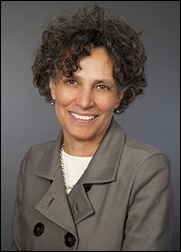Frontline Blog
New Way to #WatchTheSalt at NYC Chain Restaurants
March 2016

The New York City Board of Health recently counted an important victory in the battle against cardiovascular disease. A court upheld the health department’s right to warn New Yorkers about the sodium in certain menu items at chain restaurants. “Information is power,” said Supreme Court justice Eileen Rakower, of the board’s efforts to help consumers make better choices.
To mark March as National Nutrition Month, the Big Cities Health Coalition reached out to New York City Health Commissioner, Dr. Mary Bassett to hear why the warnings, and the department’s #WatchTheSalt campaign, is so important to the health of those in the Big Apple.
By Commissioner Mary T. Bassett, MD, MPH

Over the last few months, diners in New York City may have noticed a change to menus at chain restaurants. A salt shaker inside a small triangle now appears next to some menu items to let New Yorkers know that item has 2,300 milligrams or more of sodium – more sodium than should be consumed in an entire day.
The sodium warning rule is the first of its kind in the United States. The proposal was passed unanimously on September 9, 2015 by the New York City Board of Health, and implementation began on December 1, 2015. The simple sodium icon provides diners with a useful warning at an actionable time – when they are reviewing menus and deciding what to eat. The rule also requires chain restaurants to post a warning statement about the risks of consuming too much sodium.
Consuming too much sodium can lead to high blood pressure, a risk factor for cardiovascular disease, including heart disease and stroke. Cardiovascular disease is the leading cause of death in both New York City and the United States. In 2013, heart disease claimed over 600,000 lives in the United States and nearly 17,000 lives in New York City. In New York City, another 1,700 lives were lost due to stroke in 2013. In New York City, these diseases do not take all lives equally. Rates of premature death due to heart disease among Black New Yorkers are 80% higher than rates among White New Yorkers. Black and Hispanic New Yorkers have higher rates of high blood pressure compared with White New Yorkers.
Many Americans unknowingly consume more sodium than what’s recommended. The average New York City adult consumes about 3,200 milligrams of sodium every day, nearly 40% more than the recommended daily limit of 2,300 milligrams. This hidden salt is most often found in processed and restaurant foods, which is concerning because Americans are eating out more than ever. In 2012, 43% of money spent on food was used to purchase food prepared outside of the home, compared with 26% in 1970.
Food served at restaurants typically contains more sodium than food that is prepared at home. For example, an Italian sandwich at a popular chain restaurant has nearly 3,000 milligrams of sodium. A milkshake at another chain restaurant contains almost 3,400 milligrams of sodium. Because high sodium foods don’t always taste salty, the warning label can help consumers easily identify and avoid very high sodium items.
The New York City Board of Health has a long tradition of addressing public health challenges with sound policy. Similar to the NYC calorie labeling requirement, the sodium rule provides diners with information to make informed choices about their meals.
Diners have a right to know if a single menu item has more sodium than should be consumed in an entire day. I encourage everyone dining at these establishments to use this information to make informed and better decisions for their diets and their health. If you see the warning label while dining out, take a picture and use #WatchTheSalt to share your photo on social media!